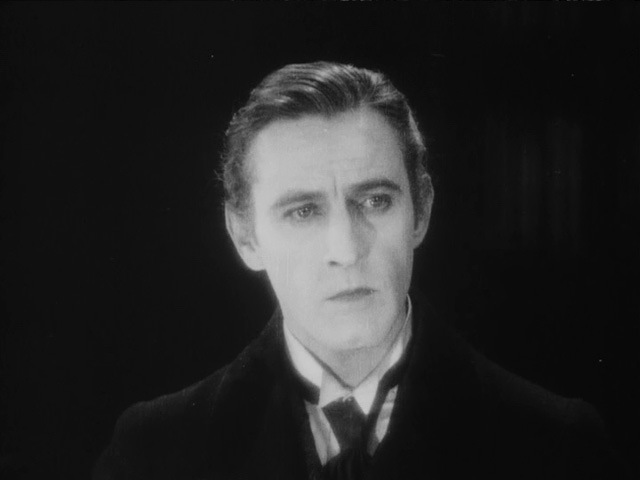Tonight's "rerun":
SHERLOCK HOLMES (1922)
This 2nd time around, I've not only seen the
1916 film twice, but along the way, dug out the
1981 Frank Langella recording of the live stage play. So the differences are far more pronounced in my mind this time.
The
1922 film, released in the UK under the title "
MORIARTY", severely increases his screen-time and importance to the whole story, to the actual detriment of the Alice Fauklner storyline.
In this one, we see Moriarty trying to gain influence over the future Crown Prince. The son of a safe-cracker, Forman Wells, who Moriarty decided to send to Cambridge so he could meet people Moriarty could have future influence on, decides to break with Moriarty, and steals money to get away, framing the Prince for it. But Holmes confronts him over it, learns of Moriarty's existence, and tells Wells,
"Do what I tell you, and everything will work out." Later on, Wells becomes one of Holmes agents.
In a possibly-insane fit, Holmes, out of philosophical curiosity, goes to meet Moriarty, and from that brief, tense meeting, is so convinced he's a vile evil to be rooted out, he says he's found his calling in life!
We then cut to years later, where Holmes has become quite established at Baker Street, known to the general public, and a constant and increasing thorn in Moriarty's eyes. You'd think whoever wrote this film never heard of Doyle's story "
A STUDY IN SCARLET", as least as far as how Holmes & Watson met for the first time (in this film, they knew each other in college!).
After we see Rose Faulkner commit suicide by jumping off a mountain in Switzerland (in a flashback), the Larrabees ensare her vengeful sister at their home. But in this version, they don't go to Moriarty for help when their plan fails-- everything they're doing is on Moriarty's orders! Also, at least judging by the Langella version of the stage play, Mrs. Larrabee was the real brains of that marriage-- here, she barely registers compared to her more-menacing-looking husband.
In the Gillette film, we see Wells set fire to the kitchen as a diversion. Here, he does it off-camera. In the Gillette film, Alice hides the letters the 2nd time behind a window shutter. Here, she does it inside a hole in the outside wall behind a loose brick. ("Changes for the sake of changes.")
While it's funny to see Holmes trick Moriarty into shooting a dummy behind a curtain, it hurts that the next part of the scene is MISSING, as we next see Holmes holding Moriarty's gun, and Moriarty warning him, "
You turned down my proposition" --which we didn't see! Billy, such a big part of the play, is almost completely missing from this version.
In the Gillette film, Alice follows Larrabee to the gas works, concerned for Holmes' safety. Here, on Moriarty's orders, Larrabee takes her there by force. Every one of these scenes in this version is less impressive than it was in the earlier film (just 8 years before), OR, the performance of the live play Langella did (much of which was played FOR LAUGHS).
The climax (which actually was taken from "
Scarlet"-- Holmes slapping handcuffs on the villain disguised as a cabbie), here, is the end of the film!
"You surely don't think this is THE END?" "I was hoping so. I'm planning to go on my honeymoon!" That's shocking news to the audience, Watson, and apparently, even to Alice. The ENTIRE FINALE of the Gillette film and play are missing here, not because that part of this film is missing, but apparently by design! All that buisness about Holmes wanting to gain Alice's trust so she'd give him the letters of her own free will, COMPLETELY eliminated. We never see the Prince's people, Holmes tricking Alice, his confession of doing so to her, the actual resolution of the sub-plot about the letters... nothing.
In retrospect, this film, more than the 1916 one, seems to lead DIRECTLY into the
1932 Clive Brook film. "
SHERLOCK HOLMES", which picks up exactly where this one leaves off. You'd think they would have given it a different title... like, say.... "
THE RETURN OF SHERLOCK HOLMES". But, no, Brook did a film by that name in
1929. GO FIGURE.
Looking back, turns out there were 3 actors in this I knew. Prince Alexis was played by
Reginald Denny, who I most remember from "
REBECCA" (1940). Foreman Wells was
William Powell, alias "Nick Charles" from "
THE THIN MAN" series and before that, Philo Vance. Watson was
Roland Young, who was so memorable as the inept detective William Henry Blore in one of my favorite Agatha Christie films, "
AND THEN THERE WERE NONE" (1945).
The whole time I was watching tonight, funny enough, I couldn't get a scene from an entirely different movie out of my head. it's the wonderful scene in "
THE WORLD OF HENRY ORIENT", where Marian Gilbert is talking about her new best friend Valerie Boyd's having fallen in love with a much-older concert pianist. Boothie, Marian's mother's friend, says...
"I know how it is. I went through the same thing with John Barrymore."
"Who?"
".....WHAT did you say?"
"Who was this guy-- that you went through it with?"
"You mean you DON'T KNOW who John Barrymore is?"
"No."
"You've NEVER even HEARD HIS NAME?"
"No."
"You'll have to excuse me. It's LATER that I thought." 




